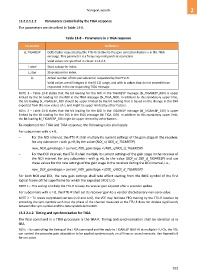Page 983 - 5G Basics - Core Network Aspects
P. 983
Transport aspects 2
13.2.2.1.1.2 Parameters controlled by the TIGA response
The parameters are described in Table 13-8.
Table 13-8 – Parameters in a TIGA response
Parameter Definition
d_TIGARESP Delta factor requested by the FTU-R relative to the gain correction factors ri in the TIGA
message. This parameter is a frequency independent real scalar.
Valid values are specified in clause 11.2.2.5.
i_start Start subcarrier index.
i_stop Stop subcarrier index.
bi Actual number of bits per subcarrier requested by the FTU-R.
Valid values are all integers in the [0:12] range, and with bi values that do not exceed those
requested in the corresponding TIGA message
NOTE 1 – Table 13-8 states that the bit loading for the NOI in the TIGARESP message (bi_TIGARESP_NOI) is upper
limited by the bit loading for the NOI in the TIGA message (bi_TIGA_NOI). In addition to this mandatory upper limit,
the bit loading bi_TIGARESP_NOI should be upper limited by the bit loading that is based on the change in the SNR
expected from the new values of ri, and might be upper limited by other factors.
NOTE 2 – Table 13-8 states that the bit loading for the DOI in the TIGARESP message (bi_TIGARESP_DOI) is upper
limited by the bit loading for the DOI in the TIGA message (bi_TIGA_DOI). In addition to this mandatory upper limit,
the bit loading bi_TIGARESP_DOI might be upper limited by other factors.
To implement the TIGA and TIGA response, the following rules shall apply:
For subcarriers with ri ≠ 0,
– For the NOI interval, the FTU-R shall multiply its current settings of the gain stage in the receiver,
for any subcarrier i with gi >0, by the value (NOI_ri/ NOI_d_TIGARESP)
new_NOI_gainstagei = current_NOI_gainstagei × (NOI_ri/NOI_d_TIGARESP)
– For the DOI interval, the FTU-R shall multiply its current settings of the gain stage in the receiver of
the NOI interval, for any subcarrier i with gi >0, by the value (DOI_ri/ DOI_d_TIGARESP) and use
these values for the new settings of the gain stage in the receiver during the DOI interval, i.e.,
new_DOI_gainstagei = current_NOI_gainstagei × (DOI_ri/DOI_d_TIGARESP)
For both NOI and DOI, the new gain settings shall take effect starting from the RMC symbol of the first
logical frame of the superframe for which the expected SFDC is 0.
NOTE 1 – This scaling is to help the FTU-R to keep its receiver gain adjusted after a precoder update.
For subcarriers with ri = 0, the FTU-R shall set its receiver gain to a vendor discretionary non-zero value.
NOTE 2 – To revive suppressed carriers (ri=0 and bi=0), the VCE may facilitate FEQ training by the FTU-R receiver by
precoding the sync symbols such that the phase of the channel measured at the FTU-R does not deviate significantly
between the sync symbol and the data symbols in the NOI.
13.2.2.1.2 Timing and synchronization for TIGA
The final command in a TIGA procedure is the SRA-R. Timing and synchronization shall be identical as in
SRA.
NOTE – By controlling the timing of the TIGA command and the reply to TIGARESP (SRA-R) at multiple FTU-Os, the VCE
can control the precoder gain adaptation to be applied synchronously on all lines or asynchronously. See Appendix II
for use cases.
973

